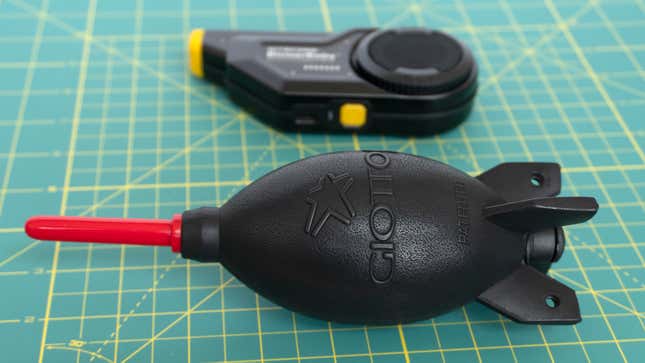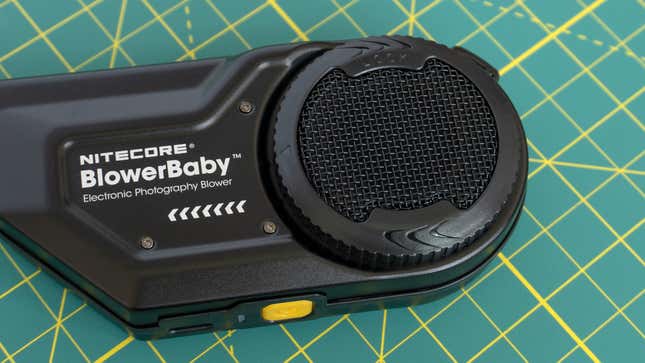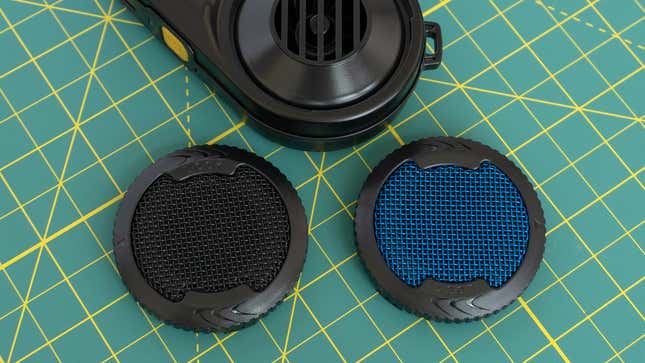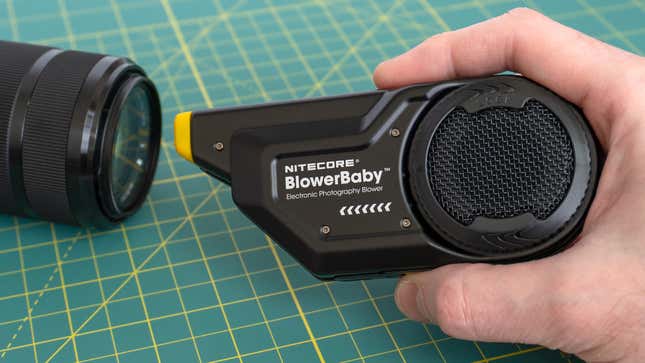Your skin regenerates itself roughly every 27 days, and the dead skin cells you shed in the process can make up almost half of the dust floating around your home. This dust, of course, eventually lands on your furniture and electronics. If you’re tired of stockpiling cans of compressed air to clean dust and dirt off your gear, Nitecore’s $100 BlowerBaby is a more satisfying alternative, even if it’s yet another photography accessory that demands frequent charging.
Dusty technology isn’t necessarily the end of the world, but when a big part of your job involves photographing gadgets for reviews, you always want them to look as shiny, new, and clean as possible. Photoshop has all the tools you need to remove dust and dirt specs from photos, but it’s an extra time-consuming step I try to avoid by simply making sure a gadget I’m photographing is already spotless. The Nitecore BlowerBaby is hands down the easiest way to do that, and quite possibly, the most satisfying dusting tool I’ve used so far.
Say Goodbye to Dust Without All the Hard Work
Over the years I’ve tried many tools for cleaning my electronics, from tiny vacuum cleaners to fine-haired brushes, but a powerful blast of air always seems to be the fastest and most effective approach to the problem.

The tool I’ve been using for the past decade is the Giottos Rocket Air Blaster, which as the name implies, looks like a retro sci-fi rocket ship. The body is made of silicone rubber you simply squeeze and the escaping air inside is directed through a thin red nozzle on top, which creates a high-pressure blast of air that’s quite effective at dealing with dust and debris.

The Rocket Air Blaster is effective, and at around $20 it’s quite cheap, but for particularly messy jobs, like tackling a keyboard after a snack, the constant squeezing quickly gets tiring. This is probably the most compelling reason to consider upgrading to the BlowerBaby. The Rocket Air Blaster can repeatedly generate quick powerful blasts of air—even more powerful than the BlowerBaby if you squeeze hard enough—but the BlowerBaby’s 44 MPH blast can be sustained for up to 15 minutes straight from its 1,500 mAh rechargeable battery, with a wider spray making bigger cleaning jobs much easier.

Pressing and holding the single button on the underside of the BlowerBaby turns it on for intermittent blasts, but for longer cleaning sessions, the button can also be double-pressed to turn the BlowerBaby on indefinitely so you don’t have to keep holding it down. It’s about as easy to use as it gets.
Swappable Filters For Different Jobs
On the side of the BlowerBaby is a fairly sizeable vent where air is sucked in through two layers of filtration, which keeps both larger and finer particles from being pulled through the device and then blasted onto the electronics you’re trying to clean.

Like the filter on a vacuum cleaner, the BlowerBaby’s filters can be easily removed. A small twist allows it to be thoroughly cleaned every so often to keep air flowing properly. It’s a minor bit of maintenance, but if you’re the type who’s frequently dusting and cleaning your electronics anyway, it’s doubtful this will be an issue.

The BlowerBaby includes what Nitecore calls its standard filter, but the company also sells an $8 alternative called the CMOS Air Filter, which is for those who prefer to use dusters to clean the sensors on their digital cameras. Mirrorless cameras might be far more compact than DSLRs while being just as capable, but the lack of an internal mirror means that dust and dirt can more easily end up on the sensor when swapping lenses, often requiring frequent cleanings.
There are two approaches to sensor cleaning: swabs that directly touch and wipe the sensor clean, and blowers that blast the dirt away. The latter method is arguably easier (although it usually leaves the debris bouncing around inside the camera where it can find its way back onto the sensor) but still requires a careful approach. The BlowerBaby’s CMOS Air Filter not only filters out more particulates so cleaner air is entering your camera; it also reduces the speed of the air blasting out of the BlowerBaby from 44 MPH to around 30 MPH, reducing the risk of damage to the sensor.

There’s rarely a single tool that works well for all photographers—they can be notoriously loyal to brands and companies to a fault—but the BlowerBaby is worth embracing if you spend more time dust-busting in Photoshop than you’d like. Its aluminum body feels satisfyingly solid and helps take some of the guilt out of spending $100 on what is basically a high-powered handheld fan with a 26,000 RPM motor that makes quick work of all but the most stuck-on dirt.
I can potentially see some users wanting a variable speed option in the future, which would help prolong battery life when a less powerful blast will suffice, and maybe even compatibility with rechargeable camera batteries as photographers already keep many of them on hand, but the simplicity of the BlowerBaby is also one of its best features. Its capabilities for its size are impressive, and, dare I say it, it’s a blast to use.